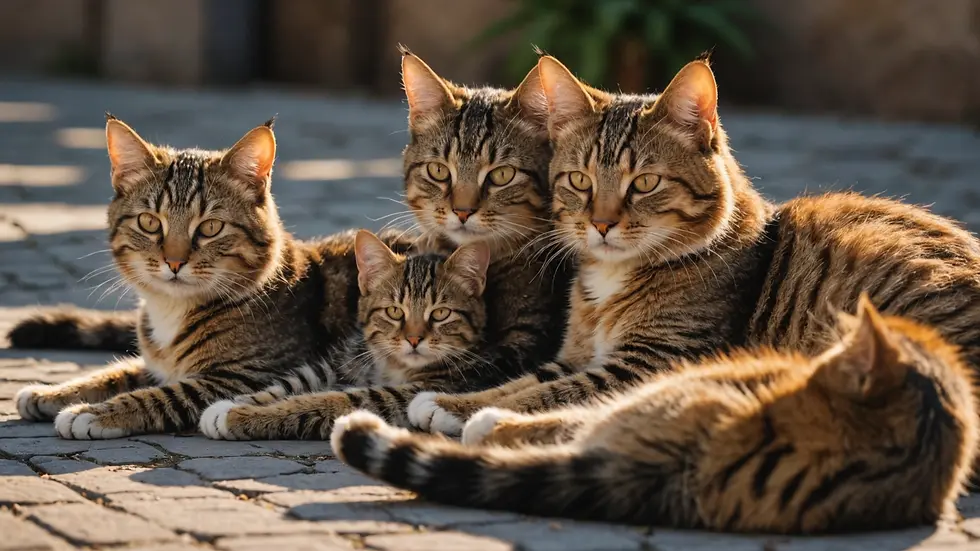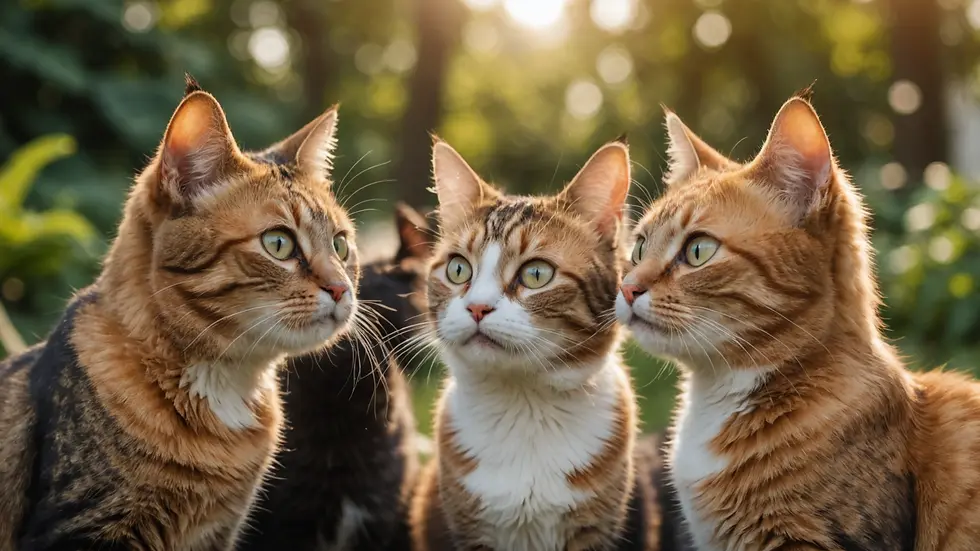Feline Friendships: Decoding the Intricate Social Dynamics of Cats
- Jyotiraj Borah
- Feb 10
- 4 min read
The world of cats has captivated human attention for centuries. Despite their reputation as solitary hunters, recent studies show their social structures are surprisingly intricate. From the warm bonds found in feral cat colonies to the dynamics of our household pets, understanding these social interactions sheds light on cat behavior, communication, and overall well-being.
This blog post explores various facets of cat social structures, outlining established knowledge, ongoing investigations, and the intriguing mysteries that still exist.
The Nature of Feline Social Structure
Many people believe cats are entirely solitary animals, but this view is overly simplistic. Various cat species, especially domestic cats, demonstrate social tendencies that defy this stereotype. For example, studies have shown that feral cats can manage community living, sharing resources and supporting each other in survival.
Research suggests animal social structures can be grouped into solitary and social categories. Feral cats often form loose colonies where they compete for food while offering mutual protection. Notably, a study in 2017 found that over 60% of feral cats live in colonies, underscoring their social nature.
Feral Cat Colonies: A Closer Look
Feral cat colonies can vary widely in size, influenced mainly by the availability of food and shelter. These groups typically exhibit matriarchal structures, where females take on the majority of caregiving and resource-gathering responsibilities.
Structure and Dynamics
A typical colony may include several related female cats and their kittens, alongside a few males. Males in these colonies often compete for mates, which naturally leads to a hierarchy. In a fascinating twist, male cats frequently leave their colonies to find mating opportunities, while females usually remain in their birth colonies.

Communication: The Language of Cats
Successful social interaction among cats relies heavily on various communication forms, including vocalizations, body language, and scent markings.
Vocalizations
Cats use an impressive range of sounds: meows, purrs, hisses, and growls, each serving a specific purpose. For instance, a mother cat uses distinct vocalizations when calling her kittens. In contrast, adult cats often hiss to assert dominance or warn off potential threats. Research reveals that cats can distinguish between vocalizations, enabling them to respond appropriately to different situations.
Body Language
A cat’s body language is rich in meaning. Their tail position, ear orientation, and overall posture convey emotions and intentions. For instance, a cat with an upright tail appears confident and friendly, while a tucked tail signals fear or submission. Understanding these signals can help cat owners foster a more harmonious environment at home.

Cooperative Behavior in Cats
Beyond communication, cooperative behaviors in cats reveal deeper insights into their social structures. Grooming, food sharing, and collective defenses against predators are all noteworthy activities.
Grooming Rituals
Allogrooming, or mutual grooming, is commonly observed among cats. Not only does this activity strengthen their social bonds, but it also helps establish hierarchies. A study found that cats engaged in grooming are 80% more likely to maintain harmonious relationships within their colonies.
Resource Sharing
Feral cats often hunt and share food in pairs or groups. This behavior is particularly beneficial during scarce resource periods. Sharing enhances social ties and reduces competition, creating a better chance of survival for all members.
The Role of Territory
Territory plays a vital role in cat social structures. Cats communicate ownership through scent markings, which convey their presence to others.
The Importance of Territory
How territorial a cat is can significantly influence its social interactions. More territorial cats may display aggressive behavior toward intruders, while more adaptable cats might accept newcomers. This dynamic can either enhance or hinder social relationships within feral colonies or multi-cat households.
Social Structures in Domestic Cats
Domestic cats also possess unique social structures, often influenced by their living conditions.
Living Arrangements
In homes with multiple cats, social dynamics revolve around distinct personalities, established hierarchies, and available resources. Cats may create territories in different areas of the house, leading to competition for cozy resting spots and human attention.
Bonding Techniques
Despite potential rivalry, many domestic cats forge strong social bonds. Cuddling, grooming, and playing are common behaviors seen among cats living together. Owners can support these relationships by offering sufficient resources like food stations and climbing spaces to minimize competition.

Factors Influencing Cat Social Structures
Several key factors affect both feral and domestic cat social structures:
Environmental Factors
Cats' social behavior is deeply influenced by environmental conditions, particularly the availability of food, shelter, and safety. For example, in safe urban areas with adequate resources, cat colonies can thrive and grow.
Genetics and Early Socialization
Genetics also plays a significant role in social behavior. Cats exposed to positive social interactions in their early lives tend to be more adaptable and thrive in multi-cat homes. According to research, 87% of kittens socialized effectively will relate better to other cats and humans as adults.
Human Influence
The impact of human behavior on cat social dynamics is profound. Community attitudes toward spaying, neutering, and feeding can affect stray cat population sizes and dynamics. Similarly, how a cat owner manages their pets' interactions can either promote or harm domestic social structures.
The Mysteries of Cat Social Structure
Despite significant research, several mysteries about cat social structures remain:
Solitary vs. Social Nature
A key question is whether cats are inherently social animals. Some thrive in groups, while others prefer solitude. This raises questions about whether these behaviors stem from genetics or learned experiences throughout life.
Inter-Species Interactions
Exploring how domestic cats interact with other species, such as dogs, can provide further insight. Understanding these dynamics contributes to a broader view of animal communication and relationship-building across species.
Ongoing Research
Scientists continue to investigate cat social structures, examining topics like leadership roles, the effects of colony size, and how specific breeds impact social tendencies. The field remains ripe with opportunities for new discoveries that could deepen our understanding of our feline companions.
Embracing the Complexity of Feline Social Structures
The social organization of cats is intricate and layered. Whether observing the matriarchal hierarchies in feral colonies or the subtle dynamics in our living rooms, it’s clear that these creatures possess a rich tapestry of social interactions.
While we have learned much about cat communication and behavior, many questions linger, inviting further exploration. Understanding these social dynamics not only enriches our relationships with cats but also helps improve their well-being.
By embracing knowledge about their social structures, we can create environments that cater to their instincts and encourage them to thrive in a multi-cat world.




Kommentare